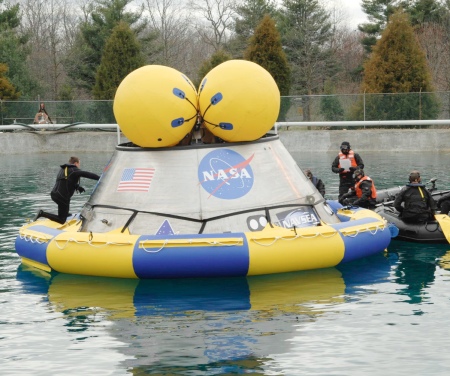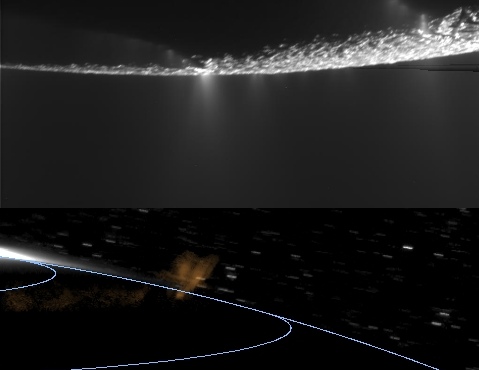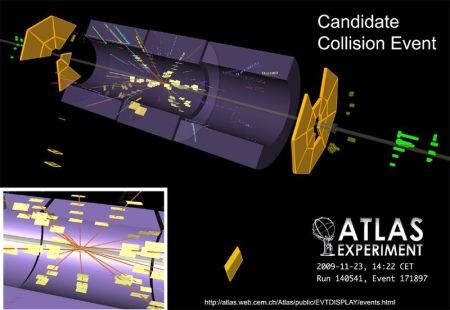 Kayla gets this week off, so your humble editor will once again tackle the exciting world of science. This week we start our post-Thanksgiving hangover by digesting some turkey facts and news. We find out that the second man on the moon is no fan of Orion, check out Cassini’s latest vacation photos from Saturn, check in on the now back online LHC, and finish off with a ringing video of the week and chrome gadget of the week.
Kayla gets this week off, so your humble editor will once again tackle the exciting world of science. This week we start our post-Thanksgiving hangover by digesting some turkey facts and news. We find out that the second man on the moon is no fan of Orion, check out Cassini’s latest vacation photos from Saturn, check in on the now back online LHC, and finish off with a ringing video of the week and chrome gadget of the week.
Turkey…in…SPACE!
Yesterday on Thanksgiving, astronauts aboard the Space shuttle Atlantis checked their pantry for the usual astronaut food, but instead found turkey dinners awaiting them. The surprise meals were made up of smoked and irradiated turkey, along with pouches of candied yams and freeze-dried cornbread stuffing and green beans — just add water! A NASA spokesman told AP that the meals were snuck on board by the crew of the International Space Station before Atlantis departed Wednesday. More info at AP.
Speaking of turkeys, the Discovery Channel has some facts about turkeys for you to ponder with your leftovers…
Buzz doesn’t like Orion
The second man on the moon, Buzz Aldrin, doesn’t pull punches (catch this video of him punching a "moon hoaxer"). Buzz has taken a look at the Orion project, which will be replacing the Shuttle fleet with a return to old school capsules, and he doesn’t like what he sees. In a new editorial titled "In Search of a Real Spaceship", Buzz notes:
Space capsules? That’s right, instead of following the Shuttles with something as capable – something that can guarantee American space leadership – we’re going to race China, India, and Russia in a competition to build a limited and ungainly spacecraft that America retired a generation ago. And guess what? It will take another seven years before the NASA Orion capsule is ready to ferry astronauts. And that’s on top of the five years we’ve already spent designing the thing. Seven more years, when we went from Mercury through Gemini to Apollo in less than five (the first unmanned Apollo test flights began even before Gemini carried astronauts, for Pete’s sake). And it will cost the taxpayers, oh more than $50 billion for these Orion capsules and their booster rockets! Washington, we don’t have liftoff..

Navy divers practice recovery on new Orion capsules – Buzz thinks this is no way for a 21st century astronaut to land
Saturn’s Aurora movie + Enceladus Geysers
The Cassini spacecraft in orbit around Saturn has had a busy week. On November 21st it buzzed Saturn’s moon Enceladus again (from just 2000km above the surface), and got some spectacular images of the moon. The icy moon revealed what appears to be some ideal locations for skiing, and caught some of those geysers in action as well. All the images are available at ciclops.org. And on the 24th Ciclops released a movie showing the aurora effect from Saturn’s north poll. Again, check it out at ciclops.org.

Cassini continues to be one of the coolest cameramen spots in the solar system
LHC Colliding Protons Again
Last Friday, for the first time since September 2008, the Large Hadron Collider (LHC) went back online and circulated a beam of protons around the 17 mile-long ring of supercooled electromagnets. On Monday it was reported that the first proton collisions had occurred, which Discovery notes "weren’t expected for another two weeks." Once again, the LHC is functioning as the world’s most advanced particle collider. Now the work of hunting for the elusive Higgs boson (aka ‘the god particle’) can begin in earnest. More at Discovery.com.

LHC one step closer to answers…or Armageddon…whichever you prefer
Video of the week: The Earth with Rings
3D artist Roy Prol decided to take a look at what the Earth would appear like if it had Saturn-like rings (from Space and from various spots on the surface).
Gadget of the Week: Google Chrome
The following video shows off how Google’s new ‘Chrome’ operating system, combined with their ‘Chrome’ browser can revolutionize computers, especially those ‘netbook’ type devices.

Ok. Im going to Cassini and Ill have my Sky poles ready. Wow Buzz. Come on. Tell us what you realy think and please do not hold back any more. But you are so very right. Here we go with the colider again. Any betes on how long it will last and how much money it will cost. Anthony. Great job once again.
I fear no one will be listening to Buzz.
Oh. Turkey in Space. So which ones are the Turkeys. Lol. I wonder what the Aliens think about that that are watching. or is that the Vs. They do have a fleet out there somewhere and they may be coming to have us for there Thanksgiving. Yikes.
Buzz is a champ.
Rings around Earth would be beautiful! Though I feel like the rings would have unforeseen consequences, like severe changes in Earth’s weather patterns or something.
Jeez…
I just passed the 3 minutes of Rings around the Earth with my mouth open!
AMAZINGLY BEAUTIFUL!!!
Congrats to the designer Roy Prol.
That second photo could easily be seen as a face with the yellow balloons as eyeballs.
Just a random comment.
With the “new” space capsule in the works we wil have to have a remake of Gilligan’s Island soon too.
The ring thing was cool … but … wouldn’t the gravitational interaction between Earth and Moon pretty much wipe out a ring system? Still, the images were fantastic!
I totally agree with Buzz. He’s right, we allready did this, and retired them. How about something like the shuttle, only better? Or why not simply update the design of the shuttle and build new ones? I think the one’s we have were built in the 80’s, so over 20 years they’ve been in use. update the design, and maybe we’d be good until 2030. Couldn’t get to the moon in them, but at least we could get to the ISS.
9 – um, yup. The moon also stabilizes our seasons. Rings may be nice, but I’ll take our super-fantastic one-of-a-kind in the solar system Moon.
Totally agree with Buzz. NASA has a great history, but I’m praying that private industry finds a profit motive up there and eclipses these wasteful and sluggish projects.
I can’t say that Mr. Aldrin doesn’t have it nailed. Because he does. A lot of us around the world were hoping, expecting the shuttle fleet to be replaced by a fleet of better shuttles. Instead we get Apollo revived with laptop computers added into the mix?
And we know there are companies working on building better shuttles and not waiting on NASA, CSA, ESA, NASDA or any other nation or coalition of nations to throw any contracts their way.
I’ll say it, since no one else has.
Why are we getting capsules when we are supposed to be figuring out shuttlecraft? At this rate, we’ll never build the Big E!!
Done.
I’m with Buzz Aldrin! NASA, in my opinion, is taking a step backwards by utilizing space capsules reminiscent of the aged Apollo.
It is a crime that a new space shuttle program is not being planned!
What is really too bad is we don’t have “sleeper ships” as seen in “Space Seed”. Instead all we’re getting is a retread of the old capsule modules. Oh well, at least we haven’t genetically engineered people with them ending up like Khan Singh. Yet.
The video featuring the rings around earth was well done.
Thank you, Anthony, I ended up not missing Kayla(no offense to her of course, she is wonderful).
Splashdowns?
Our space program has has now officially become a laughingstock.
Progressives always hold progress back.
How is it that we do not have rotating space stations yet?
This is some future we’re having.
@14
Here it is:
http://snipurl.com/tg8ar
Woo hoo.
Buzz is my hero!!! AGAIN!!!
As said last week after the rocket test: OLD tech! I’m not against going to the Moon and beyond – but in a long-lasting way. and you don’t do that with capsules. What one needs is a bigger spacecraft, most likely built in space for exploration and colonisation mission to Moon, Mars and the Jupiter & Saturn moons.
To build such a spacecraft in Earth orbit you need a workhorse delivering the parts – a new and improved shuttle system.
Another thing I think is needed what most poeple don’t like: The spacecraft for deep space missions has to be equipped with a nuclear reactor to provide enough thrust to get us to Mars and the outer planets. Look at 2001 and Trek’s impulse engines: Nuclear is the way to the stars – today to power a powerfull ion-drive.
I don’t care if we have to use Conestoga wagons with thrusters instead of wheels, as long as we stop going around in circles around the Earth, as I’ve said in my blog. Capsules or shuttles, anything will do.
(Here I go again)
We should have picked the X-33 as the replacement for the shuttle fleet.
What’s next? Chevy will re-tool the 1976 Camaro as the new flagship vehicle for their 2010 line-up?
Indeed, the bureaucratic mentality really is the only constant in the universe.
I do agree with Buzz, it seems NASA’s just kind of phoning the whole Orion project in. Where’s the innovation, efficiency and eagerness that the United States seemed to have in the 60’s and 70’s?
That being said, the Space Shuttle DOES need retiring, and I would much rather have the Orion than nothing.
I guess this is what we get when NASA is populated with politicians rather than real scientists and engineers.
The VentureStar was unfortunately undone by, among other things, the weird inside-out engine bell design which was supposed to be far more efficient at altitude than the current ones.
But who knows what black projects lurks in the hearts of our military?
Again, for those who think that the U.S. is falling behind, I prithee you Google “X-37” for an idea of what it is actually capable of. The X-37 is a drone spaceship that, as built, may be capable of deploying hardware for orbital, military, or other purposes. While quite small by Shuttle standards, it is most likely very scalable and could easily serve, even now, as a space fighter, attack craft, or, potentially, orbital bomber. It’s already been air-dropped during in a test flight in which a B-52 served as its mother ship.
NASA’s affiliation with the project has shrunk as the Air Force’s has expanded. The entire project has an air of secrecy about it that invites speculation.
Officially a technologies demonstrator, the X-37 is scheduled to be launched next year.
Source consulted: Recent story in Space.com.
#11 & #12
“Do you want to know what my vision was? Money!”
Good Ol’ Zephram knew what he was talking about.
T.’.
#22 Exactly. NASA will be working at the same level, more or less, as our international counterparts, and we’ll keep our space superiority stuff within the military. Heh heh heh.
#16 I’m a progressive. I do not think all ‘conservatives’ or ‘liberals’ generically do one damn thing consistently. There’s your IDIC for you.
T.’.
NASA is so conservative and stuck in rut now. It is such a shame. My collegue used to work for NASA and she said that there is no original thinking there anymore. They just go through the motions now, like a routine. There is very advancement.
24, interesting point, indeed.
If you look at what we have in terms of overall national power, we actually have it pretty good, assuming that Project Constellation is maintained.
We still have both EELV’s (Boeing’s Delta and Lockheed Martin’s Atlas, both now jointly operated), either of which can easily serve as the world’s most powerful boosters (aside from the Shuttle STS). In fact, the Heavy versions of both are, I believe, the most expendable powerful operational rockets in the world today (though nothing compared to the Saturn V). See: http://en.wikipedia.org/wiki/Comparison_of_heavy_lift_launch_systems
We also have the Falcon 9 Heavy, a privately funded vehicle whose development is progressing nicely. We have already have a prototype private space station in orbit, operated by Las Vegas-based Bigelow Aerospace. Virgin Galactic is using Burt Rutan’s technology for its VSS Enterprise-class spaceships. The COTS program which has contracted out for Spacex’s Falcon and Orbital Science’s Cygnus program and other hardware under development, is doing well.
And then there is the X-37 and probably a number of other highly guarded, highly developed programs not generally known to the public. Some of the latter include top secret payloads about which nothing except the name is known.
What can be done with this technology is limited only by the imagination and the laws of physics.
See also “Space Shuttle, Jr.,” a magazine article I found after posting my initial message above about the X-37. Comes complete with large photos.
http://www.airspacemag.com/space-exploration/Space-Shuttle-Jr.html?c=y&page=4
Now don’t label me as an uncaring conservative for what I’m about to say because if the government didn’t tax the average person so much, the average person would have more money to donate to charities and the poor themselves and might be able to afford health care for themselves too.
In the same vein, part of the reason government taxes us so much is because they pour so much money into welfare programs that don’t teach people how to fish (as the old saying goes) but just gives them enough fish to get them to keep voting for the guy that gives them the fish.
So while the government is wasting money on cradle to grave handouts, we don’t have any money left to fund a truly exciting new space vehicle development program like Apollo was and the shuttle originally was. NASA’s funding is only .6% of the USA’s yearly budget!
I don’t see what the problem with Orion is. It only looks like the Apollo capsule — all the major tech improvements are on the inside, where they ought to be, right?
The only way for space travel to advance is by a joint public/private multinational co-operative. The idea that it is entirely NASA’s business is wrong. The costs for space exploration are “astronomical’ and is too heavy a burden on taxpayers. Having more private companies involved means more jobs plus competetion.
@26 – nice point but as far as I know the Atlas rockets are powered in first stage by russian Energomash engines as the US engines were said to be too faulty.
“the Atlas III and Atlas V use Russian-designed/built NPO Energomash RD-180 engines. These engines are now prepared for license production by Pratt and Whitney company in the US.” – source: Wikipedia
The strongest rocket that IMO could be made available again is the the russian Enegija – used once to lift the russian Shuttle. The RD-18x engines are directly decendants from the Energija.
Next to that I’ve read in in the Wernher von Braun biography “Dr. Space” that the Shuttle engines are revamped versions of second stage Saturn engines desigend by von Braun’s team. Here also NASA is using – granted: updated – 60s tech.
Next to that the Vulcain engines developed privately for Ariane-5 are also very powerful and modern boosters.
Nevertheless: If they use Orion to land on the moon again be sure I’ll be glued to the TV screen…(-;
The J-2 that will be used on Ares are substantial improvements over the original J-2’s. The Delta uses U.S.-designed, U.S.-built RS-68 engines. While the Atlas V does use Russian technology, it has never flown in the Heavy configuration and is therefore not “operational.”
The Protons are still considered under development. The Ares I is also under development, and would be more powerful than any Proton. The Ares I would be less powerful than the Angara A7, however, but more powerful than the Angara A5. The Angara is under development as well.
The Falcon 9 Heavy is in the late stages of development and would have a thrust greater than that of the Ares I and the Angara A5.
The Ares V super heavy lift vehicle, of course, would be in a whole different league altogether and would have more than four times the lifting power of the Angara A7. The Ares V would be 35 per cent more powerful than the most powerful rocket in history, the Saturn V.
Source: Wikipedia.
Ever since the Orion initiative was announced, my opinion has been very close to Buzz’s, especially the ‘retro-teching’ aspect of NASA’s proposed successor to the SSN program.
This reflects a growing problem within the US, not just confined to NASA. As a society, we have grown so profligate and litigious that many projects like Orion are significantly delayed, simply because there’s too much bureaucracy, meddling, and money. No one wants to trim the fat, because everyone’s got their fingers in the pie.
A comparable example of this trait is the Ground Zero reconstruction in lower NYC. Eight years after 9-11, and not a single building or permanent memorial is up. Litigation still continues. Compare this with the Tokyo SkyTree project, a 2000′ ft tower under construction that it scheduled to be be finished in less than 3 yrs.
A further example is the TARP recovery bill, which in 10 months has created a total of 30,000 jobs (as opposed to the sum bonuses one Wall St. investment firm paid to its execs out of the TARP monies in FY Q2…monies that could have funded 100,000 jobs at 30K a yr).
A disturbing trend, pointed out by Carl Sagan in the 1990s, was the lack of ‘pure’ science research, and the near-monopoly of corporate-funded research with ‘tech’ applications as endgoals. He reasoned that corporate oversight in research effected a stasis on ‘hard’ science research, while investing billions in developing a better cellphone/TV/whathaveyou.
It also has been posited that science has reached an endpoint as far as ‘hardcore’ technologies are concerned. Yes, we can build smaller microprocessors and smarter cars…but initiatives like the SST, the SpacePlace, etc have been stalled since the 1970s. I sense that we hit a ceiling with the shuttle, one we’ll never eclipse unless we undergo a quantum shift in the philosophy and ethics of science research coupled by a forward-thinking approach that eschews the cumbersome ‘pork barrel’ waste and is more focused on results. As a culture, we seem to have lost view of the ‘grand scheme’…resulting in an ossification of initiative similar to that experienced by Qing dynasty China (who labeled Western science as barbarous), Middle Eqypt (who ignored the use of horses) and Mayan civilization (who built roads but did not utilize the cart-wheel)
It’s easy for people to chant “yes we can!” when a political candidate discusses developing clean coal tech…but actually getting it to work requires hard science. Just imagine if we handled the Manhattan Project the way we’re handling the manned space program…we’d have the atom bomb developed around the same time Elvis recorded “Jailhouse Rock”. Some of this stuff is so important, we can’t waste time ‘milking it’.
Like Buzz said, the journey from Explorer 1/X-15 to Apollo 11 took a little over 10 years…
Perhaps the 60s were a renaissance decade…and we’re now stuck in a rut, both culturally and scientifically. Fin de seicle type stuff.
You tell ’em Buzz! I totally agree. Ares 1 is a flawed design and needs to end now. I am in big favor of the Jupiter (Direct) shuttle-derived launcher. I think capsules are great but the major issue is the launcher. When we lose shuttle we’re losing both launcher and spacecraft. Really sucks! I have a feeling once shuttle retires end of next year the American manned spaceflight program will retire with it. I see no leadership in this effort. I know Obama is interested in space but I think he does not want to pay for it. I say inventment in the space program is the best stimulus package of all.
I feel that the constant criticism of the Ares I program is counterproductive in that I fail to see how the Jupiter alternative is really any better. Does anyone really think that, magically, all the bureaucracy will go away if they throw away years of Ares development in favor of some other design?
We’d be riding yet another turtle on its slowpoke way to parts unknown, only instead of being where we are today, we’d be back to square one. No one can tell me that they’ll shave years off development just because the configuration is a little different and the equipment design a little less innovative. Same thing with the EELV-based designs.
The problem is bigger than how you stack the rockets. It’s the culture of constant self-doubt that is making progress nearly impossible. Too many interests are looking out only for themselves rather than the nation’s overall objectives. And, as has well been said, we are stuck in a rut entirely of our own making.